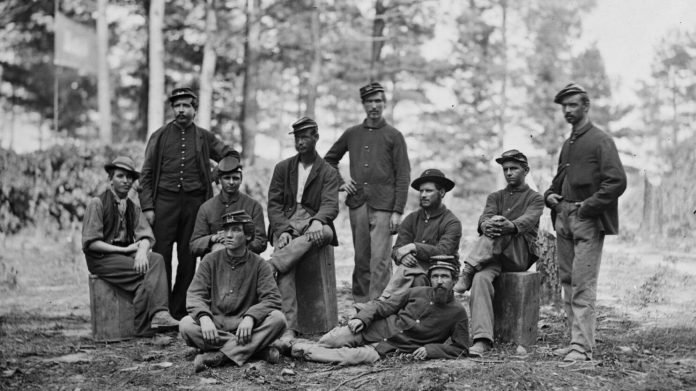Part of the University of North Carolina Press’ Civil War America “Landmark Series,” edited by Peter S. Carmichael, Caroline E. Janney, and Aaron Sheehan-Dean, the book contributes to broader scholarship examining how the Civil War transformed the national government and its relationship with the American people. Divided into two sections, A Republic in the Ranks explores how enlisted men debated the meaning of partisan loyalty in the early stages of the war and understood the significance of their political voice and how junior officers in particular directed the political engagement of the ranks. In addition to enlistment and voting records, Fry sifted through mid-to-late war newspaper accounts to reveal soldiers’ participation in both local and national politics. His reliance on a wide range of sources allows this book to trace the evolution of the army’s collective political consciousness throughout the war.
Soldiers simultaneously embraced the independence of military manhood and sought to replicate the comforts of home. Charged with electing their own junior officers, volunteer companies immediately engaged in partisan political processes. A Republic in the Ranks frames the relationship between junior officers and enlisted men as both fraternal and patriarchal. The organization of Union troops contributed to the emerging Republican consensus. Elected officers both directed the military service of their regiment and modeled moral virtue and professionalism for inexperienced soldiers. Loyalty to the Union flag and popular military figures like General McClellan initially fostered unity among men who were otherwise divided by education, ethnicity, and class. As confidence in Union leadership waned, regiments relied upon internal leadership to give voice to mutual complaints. Fry highlights the political awareness of enlisted men who filtered their war-time experiences and trauma through partisan perspectives.
The year 1863 served as a critical military turning point during the Civil War, and political engagement increased leading up to the 1864 presidential election. After months of exhausting service, soldiers not only confronted the terror of the battlefield and the reality of slavery in the South, but forged deep bonds within individual regiments. Concern about peace-at-any-price measures, pro-Confederate secret societies, and disloyalty in the ranks prompted sixty-one regiments to issue political manifestos in support of the Lincoln administration and Republican policies in 1863. Fry demonstrates the power and impact of these political resolutions, consciously crafted to demonstrate the collective voice of the armed forces. Significantly, nine resolutions with broad regional representation explicitly addressed slavery. Sentiments included endorsements of the Emancipation Proclamation, support for the enlistment of Black soldiers, and declarations that situated the abolition of slavery at the center of the war effort. These political manifestos reflected the ideological unification of enlisted men, and the emergence of the Army of the Potomac as a social and political institution neatly aligned with Republican initiatives.
Fry’s A Republic in the Ranks also explores political campaigning within the Union Army, first through surrogate ballots and later through active engagement in public discourse. Lengthy furloughs allowed soldiers to speak in public meetings, take part in local elections, and encourage support of absentee voting among the armed forces. Debates over whether enlisted men should or could cast ballots in the 1864 presidential election led to sophisticated political campaigning among soldiers and veterans. Fry identifies the formation of veteran’s clubs as an extension of the army apparatus. Pressure from these organizations and enlisted men themselves led to Edwin M. Stanton’s General Order No. 265, which outlined procedures for wartime absentee voting. Through highlighting this process, the book situates the transformation from civilian to soldier at the heart of the political transformations of the Civil War era.




